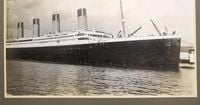It’s been more than a century since the Titanic slipped beneath the icy waters of the North Atlantic, yet its stories continue to surface—sometimes in the most tangible, glittering forms. This month, an extraordinary artifact from that fateful night is set to make waves at auction: a gold pocket watch once belonging to Isidor Straus, one of the wealthiest passengers aboard the doomed liner. The watch, along with a rare letter penned by his devoted wife, Ida, promises to fetch a staggering sum and has already captured the attention of collectors and Titanic enthusiasts around the globe.
According to BBC and The Irish News, the 18-carat Jules Jurgensen pocket watch was recovered from Isidor Straus’s body after the Titanic sank on April 14, 1912. Straus, a Bavaria-born American businessman and co-owner of Macy’s department store in New York, was traveling with his wife, Ida, when tragedy struck. The couple’s fate has become legendary, not only for their prominence in New York society but also for their enduring love—immortalized in James Cameron’s 1997 film Titanic as the elderly couple embracing as the ship goes down.
The watch, expected to sell for at least £800,000—and possibly up to £1 million—will be auctioned by Henry Aldridge & Son in Wiltshire on November 22, 2025. Auctioneer Andrew Aldridge told BBC Radio Wiltshire, “With the watch, we are retelling Isidor's story. It's a phenomenal piece of memorabilia.” The sale is already drawing significant global interest, and the watch could become one of the most expensive Titanic artifacts ever sold. Last year, a gold pocket watch presented to the captain of the Carpathia—the ship that rescued more than 700 Titanic survivors—fetched a record-breaking £1.56 million.
Isidor Straus’s journey to that ill-fated night began in Otterberg, Bavaria, where he was born in 1845. He emigrated to the United States with his family in 1854, eventually rising to become a titan of American retail and a respected politician. In January 1912, Isidor and Ida traveled on the RMS Caronia to Jerusalem, returning to the U.S. via Southampton aboard the Titanic. The couple were first-class passengers, enjoying the ship’s opulent accommodations. In a letter written aboard the liner, Ida marveled, “What a ship! So huge and so magnificently appointed. Our rooms are furnished in the best of taste and most luxurious.”
The events of April 14, 1912, would test the couple’s bond in unimaginable ways. As the Titanic struck an iceberg and chaos ensued, Isidor and Ida made their way to the boat deck. Despite his age, Isidor was offered a seat in a lifeboat, but he refused, insisting he would not go before other men. Ida, in turn, refused to leave her husband’s side. According to a spokesperson for the auction house, “As the ship was sinking, despite being offered a seat in a lifeboat, Ida refused to leave her husband and stated to him, 'Isidor we have been together all of these years, where you go, I go.'” The couple was last seen alive sitting on deck chairs, facing their fate together. Ida even handed her fur coat to her maid, Ellen Bird, as she entered a lifeboat—a final act of generosity and care.
Isidor’s body was recovered from the Atlantic days after the disaster. Among his possessions was the now-famous pocket watch, its face frozen at 2:20 AM—the precise moment the Titanic disappeared beneath the waves. The watch, believed to have been a gift from Ida to Isidor in 1888 for his 43rd birthday (the same year he became a partner in Macy’s), is engraved with his initials and carries a poignant reminder of their shared history. The watch was returned to the Straus family and has been passed down through generations, with Isidor’s great-grandson, Kenneth Hollister Straus, overseeing its recent restoration.
The upcoming auction will also feature the rare letter Ida wrote while aboard the Titanic. The letter, neatly written on Titanic stationery and postmarked “TransAtlantic 7,” was franked on board in the ship’s post office before being taken off at Queenstown, Ireland. It offers a unique snapshot of life on the world’s most luxurious liner through the eyes of a first-class passenger. The letter is estimated to fetch £150,000 and, together with the watch, forms what auctioneer Andrew Aldridge described as “one of the most iconic Titanic-related collections ever to come to market.”
“Theirs was the ultimate love story—Isidor epitomized the American Dream, rising from humble immigrant to a titan of the New York establishment, owning Macy’s department store,” said Aldridge. “It has been treasured by the family for over 113 years but now is the time for it to find a new home.” The spokesperson for the auction house echoed this sentiment, noting, “This is the reason why collectors are interested in the Titanic story 113 years later—every man, woman and child had a story to tell and those stories now are retold through these objects.”
The sale of these artifacts is more than just an opportunity for collectors to acquire rare memorabilia; it’s a chance to connect with a chapter of history defined by both tragedy and profound human resilience. The story of Isidor and Ida Straus resonates not only because of their wealth or status, but because of the choices they made in their final moments—choices that have come to symbolize love, loyalty, and sacrifice.
As the auction date approaches, anticipation continues to build. The Straus collection stands as a testament to the enduring fascination with the Titanic and the lives it touched. For the winning bidder, the pocket watch and letter will serve as powerful reminders of a night that changed history and of a couple whose devotion has echoed across generations.
In the end, it’s not just about the gold or the price tag—it’s about the stories these objects carry and the timeless lessons they still offer.




